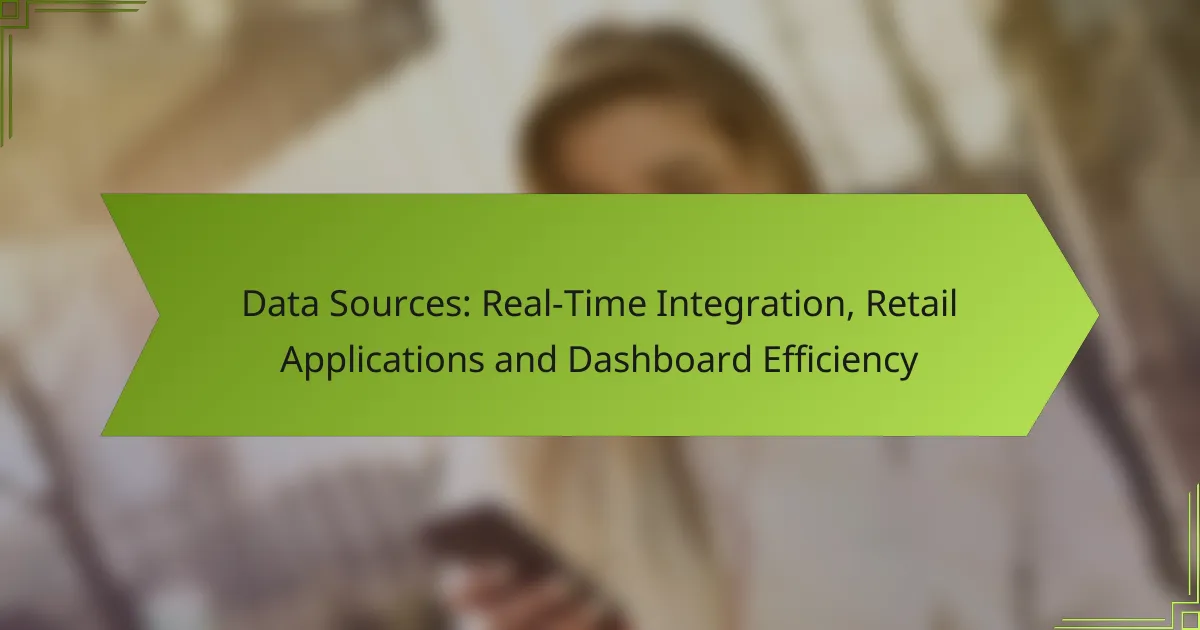Real-time data integration is essential for retail businesses, providing immediate access to vital information that allows for swift responses to inventory changes, customer preferences, and market dynamics. By leveraging tools like Apache Kafka and Microsoft Azure Data Factory, retailers can ensure a continuous flow of data into centralized systems, enhancing decision-making and operational efficiency. This capability not only improves responsiveness but also drives profitability through informed strategic actions.

What are the benefits of real-time data integration in retail?
Real-time data integration in retail provides immediate access to critical information, enabling businesses to respond quickly to changes in inventory, customer preferences, and market trends. This capability enhances decision-making and operational agility, ultimately leading to improved profitability.
Improved inventory management
Real-time data integration allows retailers to monitor inventory levels continuously, reducing the risk of stockouts and overstock situations. By leveraging accurate data, businesses can optimize their supply chain processes, ensuring that products are available when customers need them.
For example, a clothing retailer can track sales patterns in real-time, adjusting orders to align with current demand. This proactive approach can lead to a reduction in excess inventory by up to 30%, freeing up capital for other investments.
Enhanced customer experience
With real-time data, retailers can personalize the shopping experience, tailoring promotions and recommendations based on customer behavior. This level of customization fosters customer loyalty and increases the likelihood of repeat purchases.
For instance, a grocery store can analyze purchasing trends to offer personalized discounts on frequently bought items, enhancing customer satisfaction. Implementing such strategies can lead to a significant increase in customer engagement, often translating to higher sales figures.
Increased operational efficiency
Real-time data integration streamlines various operational processes, from sales tracking to employee scheduling. By having access to live data, retailers can make informed decisions that enhance productivity and reduce operational costs.
For example, a retail chain can use real-time sales data to adjust staffing levels during peak hours, ensuring adequate service without overspending on labor. This approach can improve overall efficiency by up to 20%, allowing businesses to allocate resources more effectively.

How does real-time data integration work?
Real-time data integration involves the continuous flow of data from various sources into a central system, enabling immediate access and analysis. This process ensures that businesses can make timely decisions based on the most current information available.
Data collection from multiple sources
Effective data collection from multiple sources is crucial for real-time integration. Businesses often gather data from various platforms, including point-of-sale systems, online transactions, and customer relationship management (CRM) tools. This diverse data pool enhances the accuracy and relevance of insights drawn from the integrated information.
To streamline data collection, organizations should prioritize sources that provide consistent and reliable data formats. For instance, using standardized data formats like CSV or JSON can facilitate smoother integration and reduce errors during the data aggregation process.
Use of APIs for data synchronization
APIs (Application Programming Interfaces) play a vital role in synchronizing data across different systems in real-time. They allow for seamless communication between disparate applications, ensuring that data is updated and consistent across all platforms. For example, a retail application can use APIs to pull inventory data from a warehouse management system instantly.
When implementing APIs, it is essential to consider factors such as response time and error handling. A well-designed API can respond in low tens of milliseconds, which is critical for maintaining the speed required for real-time applications. Additionally, setting up proper error handling mechanisms can prevent data discrepancies and ensure smooth operations.

What are the best tools for real-time data integration?
The best tools for real-time data integration include Apache Kafka, Microsoft Azure Data Factory, and Talend. These platforms facilitate the seamless flow of data across various applications, ensuring timely access to information for decision-making and analytics.
Apache Kafka
Apache Kafka is a distributed streaming platform that excels in handling real-time data feeds. It allows users to publish and subscribe to streams of records, making it ideal for applications that require high throughput and low latency.
When implementing Kafka, consider its scalability and fault tolerance. It can handle large volumes of data across multiple servers, which is crucial for retail applications that need to process transactions and inventory updates in real time.
Common pitfalls include underestimating the complexity of setup and maintenance. Ensure you have the right expertise in your team to manage Kafka effectively.
Microsoft Azure Data Factory
Microsoft Azure Data Factory is a cloud-based data integration service that enables the creation of data-driven workflows for orchestrating data movement and transformation. It supports real-time data integration through its event-driven architecture.
This tool is particularly beneficial for businesses already using Microsoft services, as it integrates well with Azure’s ecosystem. It offers a user-friendly interface and pre-built connectors, which can significantly reduce development time.
However, be mindful of potential costs associated with data transfer and processing in the cloud. Regularly monitor usage to avoid unexpected charges.
Talend
Talend is an open-source data integration platform that provides tools for real-time data processing and management. It offers a range of connectors and components that facilitate the integration of various data sources.
Talend’s strength lies in its flexibility and ease of use, making it suitable for organizations of all sizes. It allows for both batch and real-time processing, which is essential for retail environments that require timely updates.
One key consideration is the learning curve associated with its extensive features. Invest time in training your team to maximize the platform’s capabilities and avoid common integration challenges.

How can retailers implement real-time dashboards?
Retailers can implement real-time dashboards by defining key performance indicators (KPIs), selecting suitable dashboard software, and integrating various data sources. This approach enables businesses to visualize performance metrics and make informed decisions quickly.
Define key performance indicators (KPIs)
Establishing clear KPIs is essential for effective real-time dashboards. Common KPIs in retail include sales per square foot, inventory turnover, and customer satisfaction scores. These metrics should align with business objectives and provide actionable insights.
When defining KPIs, consider both leading and lagging indicators. Leading indicators, such as foot traffic and online engagement, can predict future performance, while lagging indicators, like total sales and profit margins, reflect past results. Aim for a balanced mix to gauge overall health.
Select appropriate dashboard software
Choosing the right dashboard software is crucial for displaying KPIs effectively. Look for platforms that offer real-time data visualization, user-friendly interfaces, and customization options. Popular choices include Tableau, Power BI, and Google Data Studio.
Evaluate software based on compatibility with existing systems and ease of integration. Some tools may offer built-in connectors for popular retail systems, while others might require custom API integrations. Consider trial versions to assess functionality before committing.
Integrate data sources
Integrating diverse data sources is vital for comprehensive real-time dashboards. Retailers should connect point-of-sale systems, e-commerce platforms, and inventory management tools to gather relevant data. This integration ensures that all metrics are updated in real-time.
Utilize data integration tools or middleware to streamline the process. These solutions can automate data collection and reduce manual entry errors. Regularly review and update integrations to accommodate new data sources or changes in business operations.

What are the top retail applications of real-time data integration?
Real-time data integration in retail enables businesses to make informed decisions quickly, enhancing customer experience and operational efficiency. Key applications include dynamic pricing, personalized marketing, and supply chain optimization.
Dynamic pricing strategies
Dynamic pricing strategies leverage real-time data to adjust prices based on market demand, competitor pricing, and inventory levels. Retailers can implement algorithms that analyze these factors continuously, allowing for price changes that can occur within minutes.
For example, an online retailer might lower prices during off-peak hours to stimulate sales or raise them during high-demand periods. This approach can increase revenue by up to 20% in competitive markets.
Personalized marketing campaigns
Personalized marketing campaigns utilize real-time data to tailor promotions and advertisements to individual customer preferences and behaviors. By analyzing browsing history, purchase patterns, and demographic information, retailers can create targeted messages that resonate with specific segments.
For instance, a retailer could send personalized discounts to customers who frequently purchase certain products, enhancing engagement and conversion rates. This strategy often leads to a significant increase in customer retention and loyalty.
Supply chain optimization
Supply chain optimization involves using real-time data to enhance inventory management, demand forecasting, and logistics. Retailers can track product movement and stock levels in real-time, allowing for quicker responses to changes in demand and reducing excess inventory costs.
For example, a grocery store can adjust its orders based on real-time sales data, ensuring that popular items are always in stock while minimizing waste. Effective supply chain optimization can lead to cost savings of 10-30% in operational expenses.

What criteria should retailers consider when choosing a data integration solution?
Retailers should prioritize scalability, ease of use, and implementation speed when selecting a data integration solution. These factors ensure that the system can grow with the business, be user-friendly for staff, and be deployed quickly to minimize disruption.
Scalability of the solution
Scalability refers to the ability of a data integration solution to handle increasing amounts of data and transactions as a retailer grows. A scalable system can accommodate more data sources, users, and functionalities without significant performance degradation.
When evaluating scalability, consider whether the solution can support various data types and volumes. For instance, a solution that efficiently manages hundreds of thousands of transactions per day may be necessary for larger retailers, while smaller businesses might only need to handle thousands.
Additionally, look for solutions that offer cloud-based options, as these often provide better scalability through elastic resources. This means you can increase or decrease capacity based on demand without major investments in infrastructure.
Ease of use and implementation
Ease of use and implementation are critical for ensuring that staff can quickly adapt to the new data integration solution. A user-friendly interface can significantly reduce training time and improve overall productivity.
When assessing ease of use, check for intuitive dashboards, straightforward workflows, and comprehensive support documentation. Solutions that offer drag-and-drop functionalities or pre-built connectors can simplify the integration process.
Implementation speed is also vital; aim for solutions that can be set up in a matter of days or weeks rather than months. A phased rollout can help mitigate risks, allowing you to test the integration with a smaller dataset before full deployment.

What are the challenges of real-time data integration?
Real-time data integration faces several challenges that can hinder its effectiveness, including data quality issues, system compatibility, and latency. Addressing these challenges is crucial for businesses aiming to leverage real-time data for decision-making and operational efficiency.
Data quality issues
Data quality issues can significantly impact the reliability of real-time data integration. Inaccurate, incomplete, or outdated data can lead to poor decision-making and operational inefficiencies. Organizations must ensure that the data being integrated is accurate and relevant to maintain the integrity of their insights.
To mitigate data quality issues, businesses should implement robust data validation processes. This might include regular audits, automated checks, and the use of data cleansing tools. Establishing clear data governance policies can also help maintain high standards for data quality across all sources.
Common pitfalls include neglecting to monitor data sources for changes or inconsistencies. Organizations should regularly review their data integration processes and make adjustments as necessary to ensure that the data remains reliable and useful for real-time applications.
